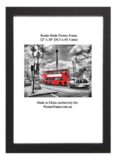They're not there any more because they've gone bust, broke, closed their doors and the owners have shut the business down!  From the once rich, booming, westernmost capital city of Perth to the staid, conservative, southernmost capital city of Hobart, art galleries are going out of business as perhaps these never have. There are several reason for this but, in the main, there aren't enough customers, people aren't buying as often and the few who do spend a lot less than they used to. Perth gallery owners complain that they've been losing money, some of them for years.
From the once rich, booming, westernmost capital city of Perth to the staid, conservative, southernmost capital city of Hobart, art galleries are going out of business as perhaps these never have. There are several reason for this but, in the main, there aren't enough customers, people aren't buying as often and the few who do spend a lot less than they used to. Perth gallery owners complain that they've been losing money, some of them for years.
In the last few years, Melody Smith Gallery, Perth Galleries, David Forrest, Galerie Dusseldorf and Gallery East have all have had to close. Another of this city's commercial gallery, Venn, closed recently due to continuing and decreasing turnover, poor patronage and high overheads. Even the Association of WA Commercial Art Galleries is shutting down, after 25 years of representing galllerists.
Other galleries throughout Australia have tried to adopt new marketing strategies and managements have tried hard to diversify. . Management said that many of their risk-taking, adventurous, innovative exhibitions were well attended but not always financially supported. When the gallery opened in their well appointed, heritage-listed building, they included a cafe bar and a design store aimed to appeal to a wider patronage and increase sales.
This was a strategy designed to strengthen the effervescent but ephemeral art market. But it didn't work out. One of the gallery's founding partners left, the the cafe' part was sold and without a significant income stream gone the gallery closed. Sydney isn't faring any better with Grant Pirrie, Gallery Barry Keldoulis, James Dorahy, Boutwell Draper, Harrison Galleries, Damien Mintonand others closing in the last few years.
In Melbourne, about a third of all art galleries have shut their halls in recent years. Increasing rents, the global financial crisis, meaner art superannuation investment and tax rules and the introduction in 2010 of the resale royalties scheme have all been adduced to contributing to the sad state of affairs. The former, in particular, has hit galleries and all art businesses quite severely.
From the 1st of July 2011, any and all art, including paintings and sculptures, bought by a self-managed superannuation fund must be insured and stored in premises away and separate for the buyers' own residences. In other words you can buy a million dollar painting but cannot claim for it as before, and display it at your own home. These rules have obviously discouraged investors because of the additional insurance and storage costs.
Worse still, these new laws are generating a progressive sell-off of art collections and into the auction market from exiting collectors. This has the unfortunate, supply-and-demand effect of forcing down the prices of the work of living artists. Local gallerists who have closed, merged or scaled down include Nellie Castan in South Yarra, Mossenson Galleries in Collingwood, John Buckley in Richmond, Catherine Asquith in Collingwood and Helen Gory's Prahran gallery.
The Australian Commercial Galleries Association believes that overall sales of new art are down 25 per cent to 30 per cent in the past few years, with indigenous artwork being the worst affected. Gallery owners have long complained of insufficient government incentives for small business, private galleries, operated in the main by only two or three person operations. This lack of support has and adverse effect on artists who hope and rely upon art galleries to expose their work to the attention of potential buyers and collectors.
Times seem to be particularly hard for private galleries showing contemporary and innovative work with many closing down. Fewer galleries obviously means less opportunities for artists to create their work and hopefully make a living. Renown Melbourne accountant and tax adviser Tom Lowenstein surveyed about 100 of his artist clients and compared their 2008 and 2012 incomes. The total income for the top tier of well-established and successful artists, dropped 46 per cent.
The second tier of mid-career artists earned 30 per cent less. Only the third tier of young, emerging artists earned more in 2012. Many are the former artists who remember the economic depression of the late 1980s when well-known galleries shut their doors. And quite a few of those artists never got publicly represented again. The art industry is not only being being deconstructed and reshaped by eBay, the internet, art fairs, pop-up galleries and a ever-globalizing art market.
Anna Pappas, the Melbourne Art Foundation chair, believes that there are about 60 art fairs around the world, , up from only about 10 a few years ago. Less and less patrons are patronizing or visiting galleries wanting to see or know new or emerging artists or to buy their art with view to being a collection. What they now do instead, is to scroll website images online at home and pre-select what they're interested in. They then fly to art fairs overseas to buy art for lucre and speculation rather than genuine love of art.
Galleries are also being affected by changing buyer habits and an ever-decreasing consumer confidence is not only affecting the top end of discretionary spending like the arts but also the wider, general fashion and retail trade as well. A hit-pocket hitting combination of carbon tax uncertainties and fear or European financial upheavals is also unsettling the formerly well-heeled an deep-pocketed mining and exploration executive classes.
To make matters worse, governmental, institutional and educational fine art purchase has markedly lessened as state governments see mining revenues drying up and budgets sliding in the red. Quasi-autonomous non-governmental organizations such as the National Association of the Visual Arts (NAVA) have been lobbying the federal government for the taxpayer-funded art funding to be doubled from what it is now to 0.17 of the national gross product as well for federal legislation ensuring artists’ social and economic rights in law.
While some point the finger at Australia's small population with its even smaller band of dedicated art collectors, corporate and institutional buyers as being a prime cause of the vanishing commercial galleries, other cities around the world are experiencing a similar art trade decline. In London, top-notch galleries in Mayfair's Bond Street are disappearing at a worrisome rate according to a recent article in The Telegraph.
Landlords have doubled, even tripled rents thanks to competition for prime retail space from global retail fashions and cosmetics brands such as Gucci and Prada who are believed to have signed on leases in excess of £1,000 x square foot. Late last year, the renown art gallerists Agnew's ceased trading after nearly 200 years. No so long ago, a shining icon of the commercial art world, the veteran master dealer Colnaghi, shut its West End gallery, after two and half centuries.
So, what does the future hold for art galleries, gallerists and artists in general? For the related topic about the picture framing industry, its prospects and employment, got to the post I want to be a picture framer, how do I become one? page









The internet has prostituted all art and all art-related products. Nothing is made here in Australian with quality materials and skilled local labour. Everything is made overseas with the cheapest materials and the lowest-paid labour. Local artists, printers, etchers, water-colorists, painters, draughtsmen have all been supplanted by cheaper, mass-produced "art" from Asian factories. Art materials, canvases, stretcher-frames, picture frames, photo frames, pencils, crayons, oil sticks, paper, palettes, art-boards, all come from overseas because that’s where the cheapest buying price and highest profit margin lies. Why buy a small, limited edition print from a known Australian artist for say, $55 to $800 when you van buy a much larger already-stretched oil on canvas for $99 as seen in at a recent Sydney Sunday market? Shame on importers, shame on art businessmen and shame on all those who are contributed to the demise of the once-thriving art scene in Australia.
It’s called evolution! Live with it! There’s nothing as constant as change! Get used to it! It’s been around for millions of years and no one can stop it, all we can do is adapt and change ourselves. There will still be artists around, but a lot less. Works of art will still be created but on different media, concepts, styles, compositions, methods, subjects, etc. As for picture framers and picture frames? These will probably change to flat boards panels or screens but the frame, at least a support for artworks, will remain. I think.
This post makes you think. What price are we paying for digital progress? What is is costing us by in terms of artistic and cultural heritage? Will we forget how to colour, sketch, draw or paint? Will all visual art be superseded by phone cameras imagery? For hundreds of years masters created by hand masterful masterpieces as Titian, Michelangelo, Rubens, Caravaggio, Turner, Degas, Monet, Picasso just to name a very few, did. Will there be no one else and no more? Has the internet also killed the artist as well as the radio star?
None of you people get it that most people want CHEAP -NOT EXPENSIVE- wall decorations. I just bought my new home at Point Cook and it’s got lots of big, empty and lonely walls! I thought about getting about 2 dozen or so bright modern posters so till up the wall. I want new, modern things because I’m young and single. I don’t want or need family or old stuff on walls. I went online to a printing and picture framing place and they quoted me about $4200 !!!!! All Australian-made frames and workmanship they said. So I went down to Caribbean Gardens and did a deal with the Chinese framers there. Price ? $1,650!! NOW, DO YOU PEOPLE GET IT?
In regard to the collapse of the Aboriginal art market, this had to happen, sooner or later. The only reason prices went so high for Koori art was the speculations of speculators disguised as investments of investors. These charlatans paid or induced hundreds of Koori artists to mass-produce dot paintings purely for the greed and lucre of art dealers, carpetbaggers and gallery owners. The dot-painting technique has no historical, traditional or cultural roots in Aboriginal history or folklore. It was invented by a white man in 1970’s for good, but misguided reasons. In other words, they’re an expensive cultural fraud foisted on both blacks and whites.